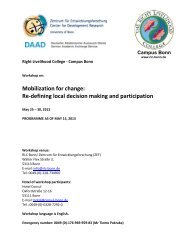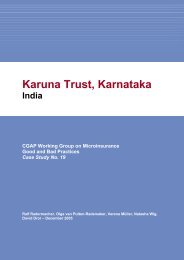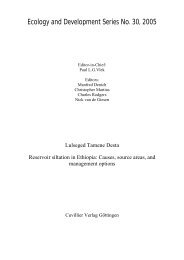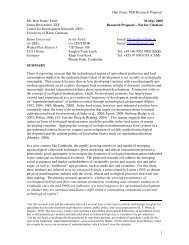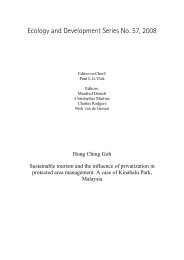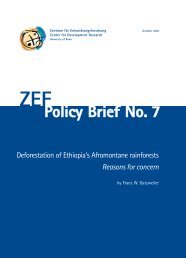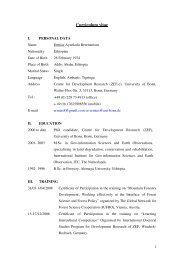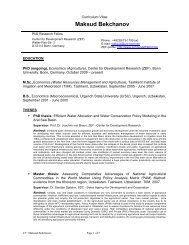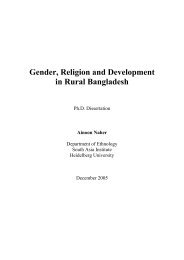ZEF Bonn
ZEF Bonn
ZEF Bonn
You also want an ePaper? Increase the reach of your titles
YUMPU automatically turns print PDFs into web optimized ePapers that Google loves.
Another popular thesis is Samuel Huntington's (1993) clash of civilisations replacing<br />
competition between communism and capitalism during the cold war. The thesis has<br />
received much attention despite its rather poor empirical performance. Ted Gurr<br />
(1994) has shown that the dividing lines in most of the conflicts since 1989 have<br />
not run parallel to the civilisational fault-lines that Huntington identified (see also<br />
Russet, Oneal and Cox 2000). It is not orthodox versus non-orthodox Christians,<br />
Confucians versus Christians, Muslims versus the rest, but rather Protestant versus<br />
Catholic in Northern Ireland, Muslim against Muslim in Iraq and Turkey, etc.<br />
The approach developed in <strong>ZEF</strong> over the last few years (cf. Wimmer, 2002; Wimmer<br />
and Schetter, 2002) explains the current wave of conflicts with the creation of new<br />
nation-states after the dissolution of the communist, multinational empires and the<br />
corresponding changes in the principles of political legitimacy. In empires, ethno-cultural<br />
distinctions may have played a certain role in defining the hierarchical strata<br />
that made up society, distinguishing between nobles and commoners, conquerors and<br />
conquered, etc. The balancing-out of relationships between these estates may therefore<br />
have entailed some political mobilisation along ethnic lines. However, ethnic<br />
relations take on completely new dynamics within the sphere of a nation-state - i.e.<br />
of a state aspiring to represent one nation. It is the institution of the nation-state<br />
that raises the question as to who may belong to its nation, because that state<br />
embodies the idea and political practice of national sovereignty. The state should, so<br />
to speak, be dyed by a nation's colour and designate the 'people' in whose name it<br />
rules over its territory. In many cases, the new elites are not capable of marshalling<br />
enough support for their project of nation-building. A fight erupts over which 'people'<br />
the state should belong to, and political mobilisation proceeds along ethnic lines.<br />
Surviving in times<br />
of war. Kabul,<br />
Summer 2002<br />
3 Morrison and Stevenson, as well as Barrows, looked at the relations between cultural pluralism and<br />
political instability in a sample of 33 African countries. The two studies yielded diametrically opposed<br />
results. Both are cited in Nelson Kasfir (1979). McRae (1983) combined measures of civil strife with<br />
indexes of the relative religious, racial and linguistic heterogeneity of 90 countries. He found no clear<br />
pattern of correlation. The debate has been recently revived with Vanhanen's (1999) book in which he<br />
tries to establish a linear positive relations between ethnic heterogeneity and violent political conflict<br />
on the basis of new data. Robert Bates (1999), however, arrives at a curvilinear relationship for a<br />
sample of African countries.<br />
Essay<br />
The current wave of conflicts is<br />
strongly linked to the creation<br />
of new nation-states after the<br />
dissolution of the communist<br />
bloc. Ethnic relations take on<br />
completely new dynamics within<br />
a nation-state, i.e. a state<br />
aspiring to represent one<br />
nation.<br />
15



